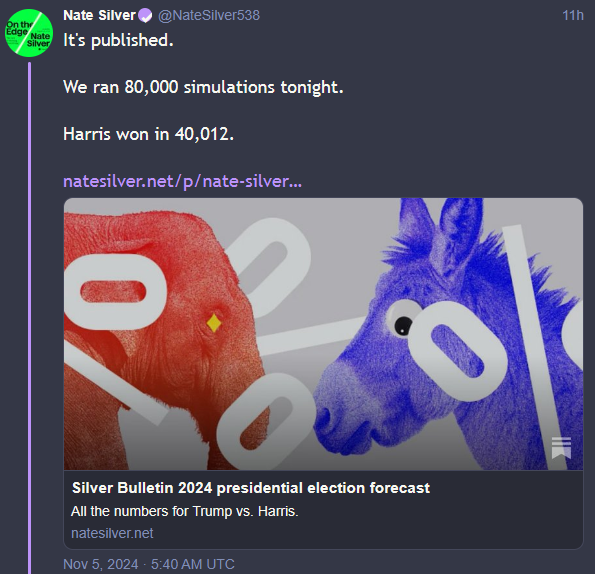The Dredge Tank
The Dredge Tank. For posting all the low tier reactionary bullshit that you can't post anywhere else. Got some bullshit from Reddit with 2 upvotes and want to share, post it here.
This community was created with the purpose that Rule 8 fans will just block it.
The rules are literally The Dunk Tank's rules, just without rule 8.
Rule 1: All posts must include links to the subject matter, and no identifying information should be redacted.
Rule 2: If your source is a reactionary website, please use archive.is instead of linking directly.
Rule 3: No sectarianism.
Rule 4: TERF/SWERFs Not Welcome
Rule 5: No ableism of any kind (that includes stuff like libt*rd)
Rule 6: Do not post fellow hexbears.
Rule 7: Do not individually target other instances' admins or moderators.
view the rest of the comments

the simulation in question:
This is much cleaner than mine that I did in python.
thanks. Nate Silver paid me $50k to write this
could you please input that into chatgpt so it will give me a summary of the code output? I'm a busy data driven guy so I don't have time for the details. however, I do have time for this post
Seems lots of unnecessary mods tbh,
S=0
for i in 1:80000
S+=rand()
end
ceil(S)
Modding by 2 is just a bitwise operation tho
Gotta dump results in some accumulate tho, and if then logic might be eh (although with branch prediction it might be auto 2 threads actually or similar utilization at least)
or similar utilization at least)
A reasonable compiler could optimize this into a bitwise AND, load the pointer to the appropriate string constant into a register branchlessly using a lookup table or cmov instruction, and then execute a single call to printf.
I mean if I want to know the precise number, like 40012 or whatever. Obviously single call is fast, but printf of 40000 strings single strings is meh. I mean in my variant I don’t run comparison, even bitwise, just 80000 rand and sum, single ceil and print
huh, the sync for Lemmy code block renderer doesn't show the \ even within the code block 👁️👁️
I'm guessing it literally is a few lines in R, plugging in the polling data after running it through a "model" (i.e. tinkering with the variables based on how polls have historically translated into votes)